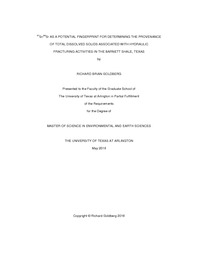
ATTENTION: The works hosted here are being migrated to a new repository that will consolidate resources, improve discoverability, and better show UTA's research impact on the global community. We will update authors as the migration progresses. Please see MavMatrix for more information.
Show simple item record
| dc.contributor.advisor | Griffith, Elizabeth M. | |
| dc.creator | Goldberg, Richard Brian | |
| dc.date.accessioned | 2016-07-08T19:52:45Z | |
| dc.date.available | 2016-07-08T19:52:45Z | |
| dc.date.created | 2016-05 | |
| dc.date.issued | 2016-05-11 | |
| dc.date.submitted | May 2016 | |
| dc.identifier.uri | http://hdl.handle.net/10106/25760 | |
| dc.description.abstract | Over the last decade there has been a dramatic increase in unconventional drilling that utilizes hydraulic fracturing to extract oil and gas. The Barnett Shale in north central Texas has been a significant contributor to this increase in unconventional production. Potential environmental contamination from hydraulic fracturing and associated activities is a topic of current debate. One concern is the management of produced/flowback water (PFW), which contains high amounts of total dissolved solids (TDS) acquired from interaction with the reservoir formation and its constituents. Development and testing of geochemical methods to determine if a particular contaminant is the result of PFW or natural sources would be valuable to industry. ⁸⁷Sr/⁸⁶Sr analysis has been shown to be a promising method for determining the provenance of TDS due to the wide variation seen naturally in ⁸⁷Sr/⁸⁶Sr on both large and small spatial scales, low temporal variability over the life of a well, and the lack of changes in ⁸⁷Sr/⁸⁶Sr during evaporation. Samples acquired from different sources, such as groundwater and PFW can contain unique ⁸⁷Sr/⁸⁶Sr values. The mixing of these two end-members will produce a curve that can verify the amount and source of a contaminant. The results of the study produced a mixing curve with end members composed of a contaminant (PFW), containing relatively high Sr concentrations and ⁸⁷Sr/⁸⁶Sr, and an “uncontaminated” sample (aquifer), containing relatively low concentrations of Sr and ⁸⁷Sr/⁸⁶Sr. The curve shows that when as little as 1% of this mixture is flowback, the “uncontaminated” sample experiences a measureable change in ⁸⁷Sr/⁸⁶Sr. To determine which phase within the reservoir rock imparts its ⁸⁷Sr/⁸⁶Sr to the PFW, sequential extractions using water, ammonium acetate, acetic acid, and hydrochloric acid (HCl) were performed on powdered core samples sourced from the Barnett Shale. Sodium was preferentially extracted with water, representing soluble salts. Barium and potassium were found primarily in exchangeable sites (ammonium acetate). Calcium and strontium were found primarily in both exchangeable sites and carbonate, and magnesium was primarily in the carbonate and HCl soluble leaches. Measurements of ⁸⁷Sr/⁸⁶Sr performed on these leachates indicate that the different phases within the shale contain distinct ⁸⁷Sr/⁸⁶Sr values. It was expected that the water leachate would provide a similar ratio of ⁸⁷Sr/⁸⁶Sr to flowback based on the assumption that it is a reasonable approximation of hydraulic fracturing fluid interacting with shale or its formation fluids. Analysis of the results indicates this might not be the case. However, the study was hindered by a limited sample set with one critical variable being unknown: whether or not the core samples and flowback sample are sourced from the same location. This is imperative to fully compare and contrast the samples. For example, flowback samples sourced from hydraulic fracturing activities in the Marcellus Shale, Pennsylvania has been shown to vary widely by collection site (Chapman et al., 2012; Capo et al., 2013). Therefore, further work should be done using this sequential extraction technique with samples (shale cuttings and flowback) sourced from the same well location. | |
| dc.format.mimetype | application/pdf | |
| dc.language.iso | en_US | |
| dc.subject | Radiogenic strontium | |
| dc.subject | 87Sr/86Sr | |
| dc.subject | Hydraulic fracturing | |
| dc.subject | Barnett Shale | |
| dc.subject | Geochemical tracer | |
| dc.title | ⁸⁷Sr/⁸⁶Sr AS A POTENTIAL FINGERPRINT FOR DETERMINING THE PROVENANCE OF TOTAL DISSOLVED SOLIDS ASSOCIATED WITH HYDRAULIC FRACTURING ACTIVITIES IN THE BARNETT SHALE, TEXAS | |
| dc.type | Thesis | |
| dc.degree.department | Earth and Environmental Sciences | |
| dc.degree.name | Master of Science in Earth and Environmental Science | |
| dc.date.updated | 2016-07-08T19:53:16Z | |
| thesis.degree.department | Earth and Environmental Sciences | |
| thesis.degree.grantor | The University of Texas at Arlington | |
| thesis.degree.level | Masters | |
| thesis.degree.name | Master of Science in Earth and Environmental Science | |
| dc.type.material | text | |
| dc.creator.orcid | 0000-0002-6728-1682 | |
Files in this item
- Name:
- GOLDBERG-THESIS-2016.pdf
- Size:
- 2.091Mb
- Format:
- PDF
This item appears in the following Collection(s)
Show simple item record


